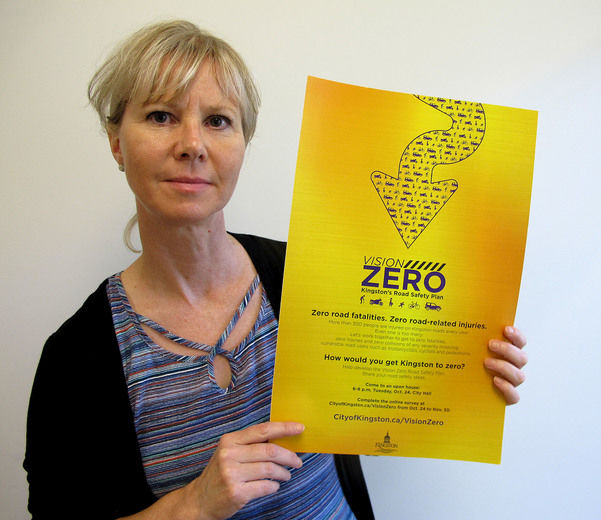
Nick Pearce/The Whig-Standard
City traffic division manager Deanna Green at her office at Kingston Public Works on Thursday July 19 2018 said no loss of life is acceptable under the Vision Zero road safety plan.
Currently, collisions cause more than 300 personal injuries and roughly three fatalities every year. Other Vision Zero programs have been implemented in cities like Toronto, Ottawa and London, but none have reached the zero death, zero injury benchmark.
Toronto’s program came under fire after continued cycling fatalities, but Kingston’s traffic division manager Deanna Green said the program is still new.
For one, she pointed to the political difficulties Toronto’s Vision Zero faced, including resistance to reducing the lanes on Yonge Street.
According to Green, the goal of eliminating collision fatalities and injuries is aspirational.
“What people have to remember is it’s a long-term strategy. It’s based on the premise that no loss of life is acceptable on our roads,” she said. “Whether we have one fatality or 20, that’s unacceptable.”
“We may never reach it. We may never have zero,” she added. “Some people look at the plan and say this isn’t realistic. We know and recognize we may never get to zero, but we’ll certainly keep trying.”
Changing driver behaviour and policy would take a large amount of political will, Green said.
“There’s been a lot of pressure on municipalities about how do you address these speeding issues. Enforcement is one solution, but there are limited resources for that.”
She said photo radar is one alternative, adding the province is close to granting approval to operate the cameras in school and community safety zones. However, the process is slow and ultimately council’s decision. Red light cameras would face similar prospects when brought before the city.
When the plan goes to Kingston city council next spring, the recommendations would likely include another look at both programs.
In the meantime, the plan hopes to reduce serious collisions by 10 per cent over the next five years.
The plan focuses on intersection and red light running, on top of paring down impaired, aggressive and distracted driving. School zones and residential areas get special attention while pedestrians, cyclists and motorcyclists are identified as the most vulnerable road users.
Intersections are the city’s biggest source of collisions, with more than 1,150 incidents between 2012 and 2016. Aggressive, younger and distracted drivers trail behind as the other main contributors to traffic collisions.
In response, the plan’s countermeasures include public education to put a cap on unsafe driving habits.
The plan’s implementation strategy involves at least three working group meetings composed of police, transportation, school board and public health representatives.
“It’s a made-in Kingston plan,” she said. “If you were to look at other plans, their emphasis areas would be different and their road safety measures would be different.”
Meanwhile, the final public open house is scheduled for the fall, while a public survey was conducted in last year. Green said this public engagement aspect allows the plan to mold its efforts to the city.
“Let’s put our resources where people really think we need to put them, rather than focusing on a particular location,” she said about community input.
While some community members may say collisions are tied to human capability or limitation, the plan’s sights are still set on its loftier long-term goal.
“No one wants someone in there family injured or killed on our roadways,” Green said.
Source: The Kingston Whig-Standard
